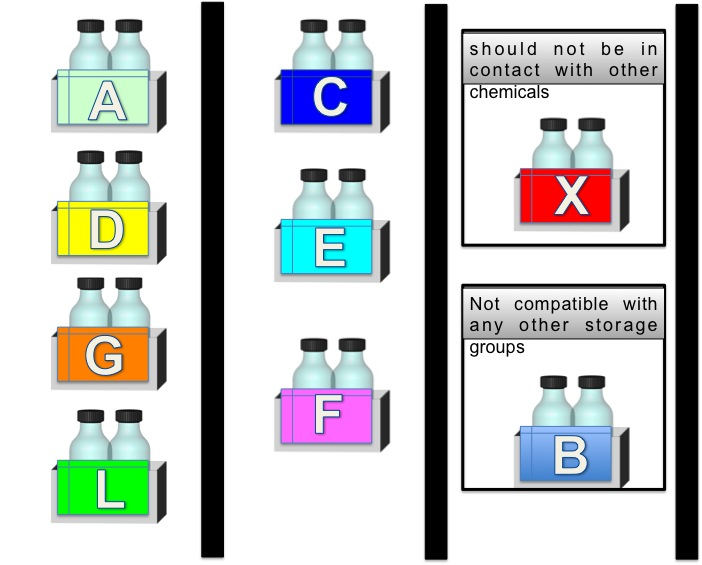- Ensure all containers of hazardous chemicals are properly labelled with the identity of the hazardous chemical(s) and appropriate hazard warnings.
- Segregate all incompatible chemicals for proper storage of chemicals by hazard class. In other words, store like chemicals together and away from other groups of chemicals that might cause reactions if mixed.
- Do not store chemicals alphabetically except within a grouping of compatible chemicals.
- Flammable materials should be stored in an approved, dedicated flammable materials storage cabinet or storage room if the volume exceeds ten gallons. Keep cabinet doors closed.
- Chemicals should be stored no higher than eye level and never on the top shelf of a storage unit. Do not overcrowd shelves. Each shelf should have an anti-roll lip.
- Avoid storing chemicals on the floor (even temporarily) or extending into traffic aisles.
- Liquids should be stored (Figure 8.5) in unbreakable or double-contained packaging, or the storage cabinet should have the capacity to hold the contents if the container breaks.
- Store acids in a dedicated acid cabinet. Nitric acid may be stored there also but only if it is kept isolated from all other acids.
- Store highly toxic or controlled materials in a locked, dedicated poison cabinet.
- Volatile or highly odorous chemical shall be stored in a ventilated cabinet. Chemical fume hoods shall not be used for storage as containers block proper airflow in the hood and reduce available work space.
- All chemicals should be labelled and dated upon receipt in the lab and on opening. This is especially important for peroxide-forming chemicals such as ethers, dioxane, isopropanol, and tetrahydrofuran. Solutions should be labelled and dated when prepared.
- Look for unusual conditions in chemical storage areas, such as:
- Leaking or deteriorating containers
- Improper storage of chemicals
- Spilled chemicals
- Temperature extremes (too hot or cold in storage area)
- Lack of or low lighting levels
- Blocked exits or aisles
- Doors blocked or open, lack of security
- Trash accumulation
- Open lights or matches
- Fire equipment blocked, broken or missing
- Lack of information or warning signs ("Flammable liquids", "Acids", "Corrosives", "Poisons", etc.)
- First aid supplies, emergency phone numbers, eyewash and emergency shower equipment, fire extinguishers, spill clean up supplies and personal protective equipment should be readily available and personnel trained in their use.
- Chemicals stored in explosion-proof refrigerators or cold rooms shall be sealed and labelled with the name of the person who stored the material in addition to all other required hazard warnings.
- Only compressed gas cylinders that are in use and secured in place shall be kept in the laboratory. All others, including empties, shall be sent to the compressed gas cylinder storage area for the particular facility.
- Keep all stored chemicals, especially flammable liquids, away from heat and direct sunlight.

Figure 8.4 Storage groups
A. Compatible organic bases B. Compatible pyrophoric & water reactive materials | J*. Poisonous compressed gas K*. Compatible explosives or other highly unstable materials |
C. Compatible Inorganic bases D. Compatible organic acids E. Compatible oxidizers including peroxides | L. Non reactive, combustible and flammable, including solvents X*. Incompatible with all other storage groups |
F. Compatible Inorganic Acids excluding oxidizers or combustibles G. Not intrinsically reactive or flammable or combustible |
Groups J, K and X requires specific storage. For further information consult to product (M)SDS and LSS.
References and sources for information from the relevant websites and documentation of different universities, NGOs and government agencies used in the preparation of this website are provided at references.